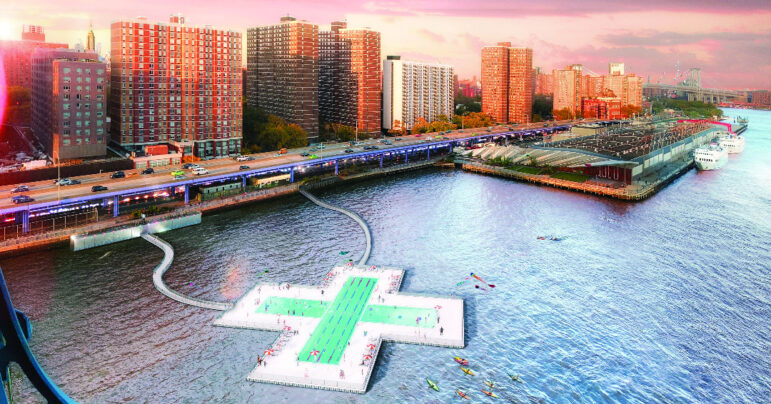“As yet another hot and humid summer approaches, exacerbated by the prospect of rising temperatures, we have fewer public pools per capita than any other major U.S. city and 520 miles of waterfront. As Paris reclaims its riverbanks for public recreation, here we sit in the Big Apple, surrounded by the Hudson, Harlem, and East Rivers, with zero access for swimming.”

Luxigon
Rendering of + POOL, a proposal for a river-sourced swim facility in NYC’s East River.A little over a year from now, a hundred of the world’s top athletes will be plunging into the murky waters of the Seine for a 1.5 kilometer swim. After it hosts the Olympics, the city of Paris plans to open 26 new floating pools—in the Seine—by 2025, four of them smack in the center of town.
This innovative expansion comes on top of thousands of Parisians who’ve been able to bathe in the Bassin de la Villette since 2016, making the French the undisputed global leaders in aquatic urban re-invigoration.
Meanwhile, as yet another hot and humid New York City summer approaches, exacerbated by the prospect of rising temperatures, we have fewer public pools per capita than any other major U.S. city and 520 miles of waterfront. As Paris reclaims its riverbanks for public recreation, here we sit in the Big Apple, surrounded by the Hudson, Harlem, and East Rivers, with zero access for swimming. Paris, the city of Vélib’ (which pre-dated Citi Bike) and the Promenade Plantée (which pre-dated the High Line), is again leading the way; and we are falling behind.
So why are we unable to access our rivers for swimming in New York City?
Simply put, the regulation around public access to our waterways has not been revisited in decades. Since then, innovative technologies, advanced engineering and process controls have been developed that can support safe river access.
We have also greatly improved our waterways. As has been reported by the New York City Department of Environmental Protection (DEP), New York’s rivers and harbors are the cleanest they’ve been in years. The average fecal coliform and Enterococcus levels have dramatically decreased over the last three decades, due in large part to the cessation of raw sewage dumping through the full build-out of New York City’s Wastewater Resource Recovery Facilities, the elimination of illegal discharges into the water body and the reduction of Combined Sewer Overflows.
At Friends of + POOL, we have reviewed many of the new technologies and advancements with scientists and health risk assessors. We have even developed some of our own. But the current NYC health code does not support public access in the waters surrounding Manhattan. And yet, when you compare data from existing bathing beaches collected under the city’s current monitoring practices, the case for river swimming with wet weather advisories is strong.
Since 2021, Friends of + POOL has been undergoing diligence for river swimming at a prospective site selected by the New York City Economic Development Corporation that is currently not supported by the existing health code. In 2021, data at the site met recreational water quality thresholds more frequently than two of the city’s already permitted bathing beaches, according to the 2021 Beach Report. In 2022, data at the site met thresholds for swimming more frequently than six existing bathing beaches and the 30-day geometric mean was better than 11 beaches currently in operation.
Mayor Eric Adams is in full support of safe river swimming. In accordance with City Planning’s Comprehensive Waterfront Plan, City Hall has directed city agencies to consider proposed solutions and develop new standards for permitting nontraditional pools and beaches, such as floating pools, to increase access. This leadership is critical given the city previously relied on the existing code and monitoring practices, which do align with federal and state guidelines, but have not yet accounted for the new and creative ways in which we have advanced in recent years.
There are plenty of ways for New York City to lead and, within city purview, create safe, conditional access points. When our regulators join cities like Paris to thoughtfully consider how our city Health Code can adopt new technologies, robust monitoring, and advanced engineering to safely access the rivers for swimming, it will give a gift to all New Yorkers that will endure for generations to come.
Let this be the last summer that we sweat it out on the streets! It’s time to reclaim our rivers for swimming. As the great Reverend Al Green says, “take me to the river.”
Kara Meyer is Managing Director of Friends of + POOL, a nonprofit that has been advocating for, and designing solutions to, safe urban river swimming since 2015.








